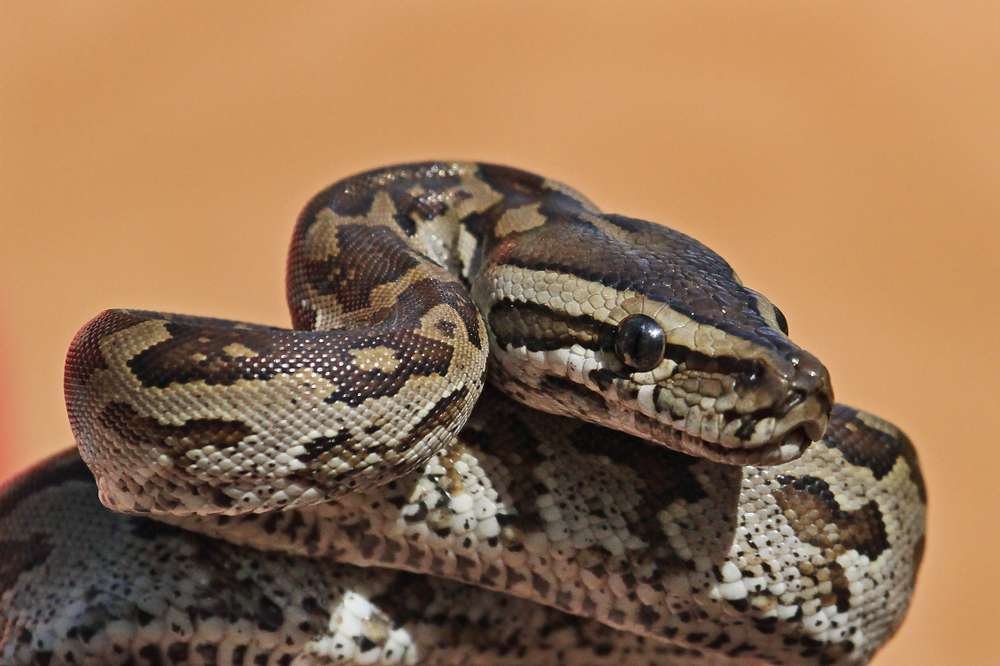Southern African Python
- Python natalensis
- IUCN Status: Least Concern
- Threat: dangerous
- Venom/Toxin: none
- Trend: stable

- Phylum: Chordata
- Class: Reptilia
- Order: Squamata
- Suborder: Serpentes
- Family: Pythonidae
- Genus: Python
Share:
General Information
The southern African python is a large, non-venomous snake native to sub-Saharan Africa. It is one of the six largest snake species in the world and is widely feared, though it very rarely kills humans. It used to be a subspecies of the African Rock Python (Python sebae), but is now recognised as a full species.
Fun Facts!
Pythons are non-venomous snakes. The southern African python has no fangs but numerous sharp, needle-like fixed recurved teeth with they use to hold onto their prey and immobilise them while they wrap their body around and start squeezing. They squeeze tighter each time their prey exhales, lessening the lung capacity with each squeeze. The prey eventually dies of asphyxiation. They kill by constricting, ambushing and coiling around their prey. As ambush predators, they strike quickly and unexpectedly. Attacks on humans are rare and fatalities virtually unheard of.
Description
They have a thick body covered with colored blotches, often joining up in a broad, irregular stripe. Body markings vary between brown, olive, chestnut, and yellow, but fade to white on the underside. The head of these snakes is triangular and is marked on top with a dark brown “spear-head” outlined in buffy yellow. Under the eye, there is a distinctive triangular marking, the subocular mark. Like all pythons, the scales of the African rock python are small and smooth. Those around the lips possess heat-sensitive pits, which are used to detect warm-blooded prey, even in the dark. Pythons also possess two functioning lungs, unlike more advanced snakes, which have only one, and also have small, visible pelvic spurs, believed to be the vestiges of hind limbs. Males in this species are typically smaller than females.
- Length: 3 - 7 m
- Weight: 40 - 70kg
- Lifespan: 12 - 30 yrs
Ecology and Behaviour
The southern African python is nocturnal and largely active at night, but is fond of basking during the day. It is at home in water and can remain submerged for long periods. During the dry season theses snakes usually become dormant. Southern African pythons are known to be very aggressive and when threatened can be extremely defensive. They usually produce a hiss as a warning sign and can give a painful bite or constrict with great ferocity.
Diet
The southern African python are carnivores and ambush predators. They feed largely on warm-blooded large rodents, monkeys, warthogs, antelopes, vultures, fruit bats, monitor lizards, crocodiles, and more in forest areas. In suburban areas, they hunt on rats, poultry, dogs, and goats. Attacks on humans are rare and fatalities virtually unheard of. Occasionally, they may eat the cubs of big cats such as leopards, lions, and cheetahs, cubs of hyenas, and puppies of wild dogs such as jackals and Cape hunting dogs.
Reproduction
The southern African python is oviparous in that they lay eggs producing 30 – 100 eggs during March, April and May, which are roughly the size of a tennis ball. The female remains with her eggs throughout incubation and the young measure 50 – 70 cm in length.
Conservation
It is categorized by the International Union for Conservation of Nature (IUCN) as, ” Least Concern “.
Distribution and Habitat
The southern African python can be found almost throughout southern Africa. They are mostly terrestrial (land creatures) though they are good climbers and can sometimes be found in trees and sometimes water. They are very good swimmers and can stay submerged for long periods of time.
Interaction with humans
Southern African pythons are often found near human settlements due to the presence of rats, mice, and other vermin as a food source. This way they help control their populations which also benefits the farmers. They are not endangered, they do face threats from habitat reduction and hunting. People are often fearful of large pythons and may kill them on sight and in some places they are hunted for leather.
No donation to this project yet.
| M | T | W | T | F | S | S |
|---|---|---|---|---|---|---|
| 1 | 2 | 3 | 4 | 5 | 6 | 7 |
| 8 | 9 | 10 | 11 | 12 | 13 | 14 |
| 15 | 16 | 17 | 18 | 19 | 20 | 21 |
| 22 | 23 | 24 | 25 | 26 | 27 | 28 |
| 29 | 30 | 31 | ||||


